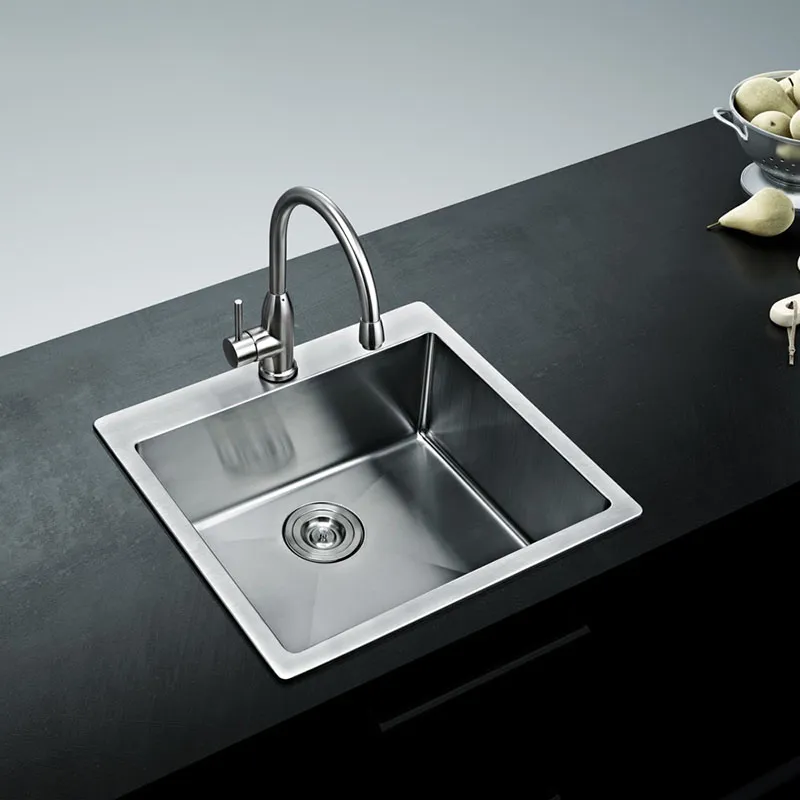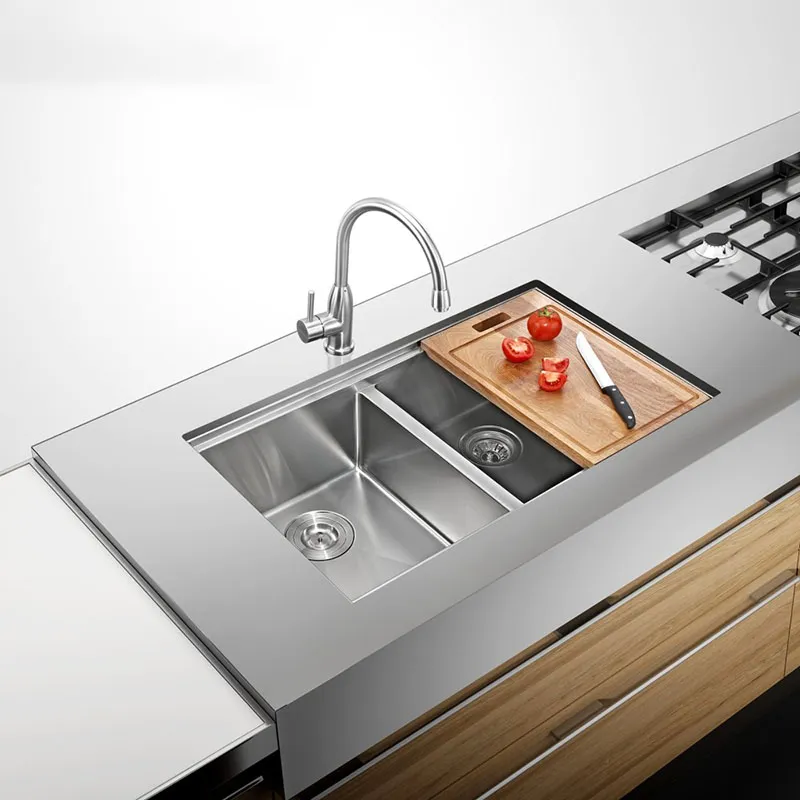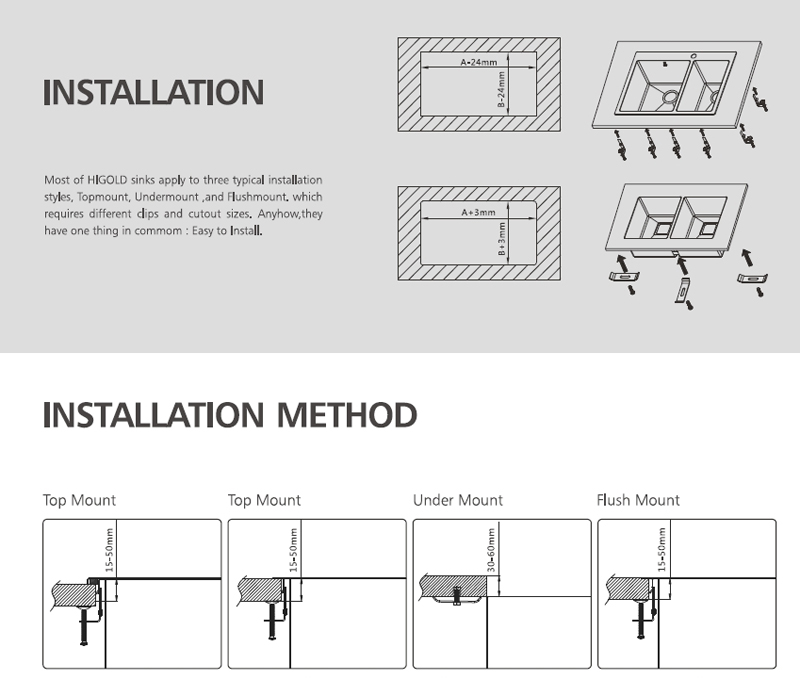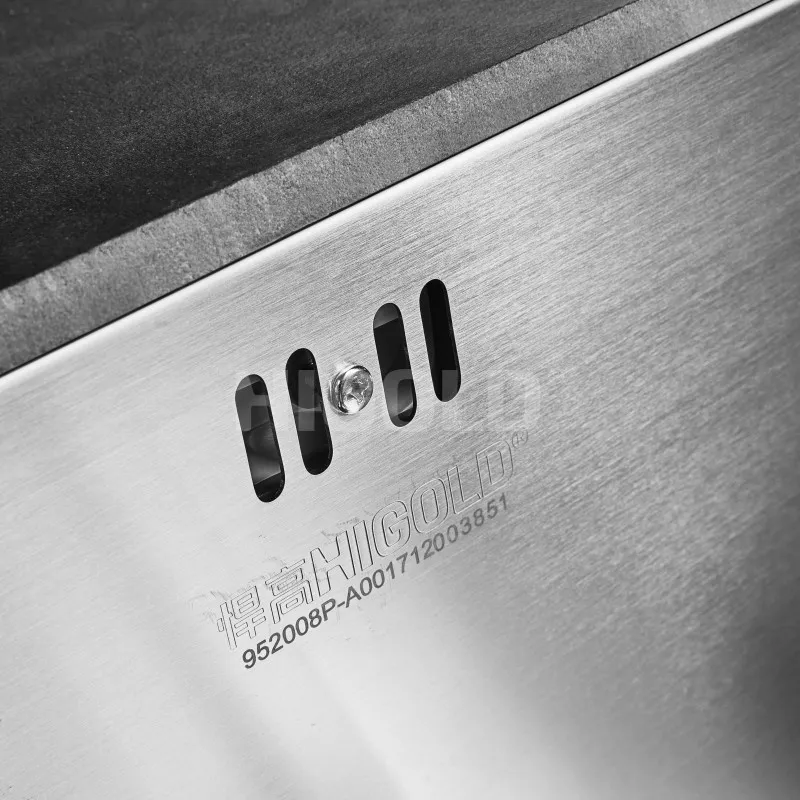As a basic fixture in everyday life, the kitchen sink's installation method directly impacts the kitchen's appearance and functionality. As kitchen design styles diversify, sink installation options have also become increasingly diverse.
The two most common installation methods are undermount and topmount sinks. While these two types of sinks differ in function and appearance, many people aren't entirely clear on the difference, especially regarding their specific type.
Many may ask, "How do I know if my kitchen sink is above-mount or under-mount?" This article will explore this question in detail, helping you determine your kitchen sink type and comparing the two.
Topmount vs. Undermount Sinks: Do You Know the Difference?
1. Topmount Sink
A topmount sink is the most traditional sink installation method. It is placed on the kitchen countertop, with the sink edge recessed into a pre-cut surface. The sink edge typically protrudes slightly from the countertop, creating a noticeable transition.
Features of a topmount sink include:
• Exposed rim: The rim of the sink is exposed on the countertop surface, with the metal rim or other material visible.
• Easy installation: Topmount sinks are generally easy to install; simply place the sink into a pre-cut hole in the countertop and secure it.
• Difficult to clean: Because there is a gap between the rim and the countertop, water stains, dirt, and food debris can easily accumulate, requiring more attention during cleaning.
• Versatile: Suitable for most kitchen countertop materials, including stone, wood, and stainless steel.

2. Undermount sink
An undermount sink is installed below the countertop, with the rim completely concealed, creating a smooth transition between the countertop and the sink. Undermount sinks are often paired with modern kitchen designs, offering a clean, modern aesthetic.
Features of an undermount sink include:
• Hidden rim: The rim of the sink is located below the countertop, making it virtually invisible and creating a smooth transition between the sink and the countertop.
• Easy to Clean: Because there are no visible seams, the transition between the sink and countertop is very smooth, allowing water to flow directly into the sink, reducing the chance of stains accumulating.
• Complex Installation: Undermount sinks are relatively complex to install and require a professional, as they require the sink to be installed from below and ensured to be secure and well-sealed.
• Limited Applicability: Undermount sinks are generally suitable for harder countertop materials such as quartz, granite, and engineered stone.

How to tell if a kitchen sink is above counter or under counter?
To answer the question, "How do I know if my kitchen sink is above-counter or under-counter?" we first need to carefully observe and compare undermount and topmount sinks. Based on the sink's appearance and installation features, we can use the following methods to determine the sink type.
1. Observe the Sink's Rim
• Exposed Rim: This is the most direct way to determine whether a sink is under-counter or above-counter. The rim of a topmount sink is usually located on the countertop, while the rim is exposed on the countertop surface and may have a noticeable metal, ceramic, or other material edge. The rim of an undermount sink is completely hidden beneath the countertop, so you can't see it, creating a smooth transition between the countertop and sink.
• Touch the sink rim: If you run your finger over the rim, you should feel a noticeable transition. If the rim is smooth and can't be felt directly, it's likely an undermount sink. If the rim is prominent and you can feel a distinct "countertop-to-sink" transition, it's a topmount sink.
2. Check the sink's installation location
• The seam between the sink and the countertop: When a topmount sink is installed, there's usually a visible seam or gap between the sink and the countertop. This gap will have some play, especially around the rim. If you notice a visible gap between the sink and the countertop, it's likely a topmount sink. Undermount sinks, on the other hand, don't have this seam because the rim is completely hidden beneath the countertop, obscuring the seam.
• Check the shape of the countertop cut: In some topmount sink installations, a slightly larger hole in the countertop is often required to accommodate the sink rim. In an undermount sink, the sink is typically installed slightly deeper than the countertop itself, resulting in a smoother cutout in the countertop, and the edge of the hole above the countertop where it meets the sink rim is barely visible.
3. Observe the countertop-sink connection
• Comparison of installation methods: Undermount sinks are typically installed from below under the countertop using adhesive and screws, leaving no visible gap between the sink and the countertop. Topmount sinks, on the other hand, are typically placed in a cutout in the countertop, leaving the sink edge visible above the countertop edge. They also typically require some type of support structure for installation. Therefore, the type of sink can be determined by the way the sink connects to the countertop.
4. Observe the difficulty of cleaning the countertop
Because the edge of a topmount sink is exposed on the countertop, it can easily collect water stains and food debris during cleaning. Therefore, if you notice a visible seam around the sink that easily collects water stains during cleaning, your sink is likely a topmount sink. The design of an undermount sink creates a smooth transition between the sink and the countertop, allowing water to flow naturally into the sink, reducing stain accumulation and making cleaning easier.

Undermount Sinks vs. Topmount Sinks: Pros and Cons
1. Pros and Cons of Undermount Sinks
Pros:
• Aesthetics: Undermount sinks offer a cleaner and more modern look because their edges are concealed beneath the countertop, creating a seamless transition.
• Easier Cleaning: With no visible seams, water flows directly into the sink, reducing the accumulation of stains and water spots.
• Enhanced Sense of Space: Undermount sinks are generally suitable for large countertop designs, adding to the overall sense of space.
Disadvantages:
• Complex Installation: Undermount sinks require the sink to be installed from below and a proper seal must be ensured, requiring professional installation.
• Limited Applicability: Undermount sinks are suitable for hard countertop materials such as granite and engineered stone, but not for wood or other soft surfaces.
2. Advantages and Disadvantages of Top-Mount Sinks
Advantages:
• Easy Installation: Top-mount sinks are relatively simple to install; simply place the sink into a pre-cut hole in the countertop.
• Versatile Applicability: Top-mount sinks are compatible with a variety of countertop materials, including wood and stainless steel.
• Easy Cleaning: While water stains easily accumulate at the seams, the edges of top-mount sinks are relatively easy to clean; simply wipe them down.
Disadvantages:
• Less Aesthetically Appearing: The edge of the sink is exposed on the countertop, potentially affecting the overall aesthetics of the kitchen.
• Difficult to Clean: The seam between the sink and the countertop is prone to water stains and food debris, requiring more time and effort to clean.

How does Higold ensure high-quality kitchenware production?
We operate Asia’s largest smart manufacturing base for kitchen and bath hardware, covering 600,000㎡. Our intelligent systems support automated welding, robotic bending, and precision grinding, ensuring durable sinks and faucets. Every product undergoes strict quality control and carries certifications such as CUPC, CSA, and CE.
When purchasing from Higold, customers benefit from low price wholesale supply, strong after-sales service, and high quality standards trusted by international brands.


